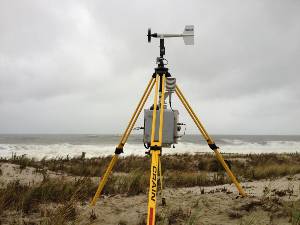StickNet
Platform History
Faculty and students at Texas Tech University have developed a versatile, rapidly deployable, 2.25 m meteorological observing station. Affectionately dubbed “StickNet” for its resemblance to a stick figure, the StickNets collect high-resolution meteorological data. The platforms are designed to be deployed in large numbers, in a short period of time (three minutes or less), and by a small number of people.
The probes are extremely versatile and can be used for numerous field studies. The original project goal was to provide a large number of surface meteorological observations from the environment near supercell thunderstorms, however the probes can quickly be adapted to collect data in the hurricane environment as well. The StickNets can be used in more benign weather conditions for studies regarding: drylines, urban wind flows, density currents, synoptic wind events, terrain induced flows, etc…
The StickNet project began in the summer of 2005 with the design of two prototype systems. The original design was developed entirely by graduate students during a summer field laboratory. The construction of the first 10 probes was completed in the spring of 2006, along with the completion of the first transport trailer. While the probes were deployed on several severe thunderstorms, the fleet did not see its first hurricane until its expansion to 24 probes in 2008.
After 11 tropical cyclone deployments, the fleet was doubled to 48 probes in 2018 to allow for measurements of a larger portion of the coastline. While the original 24 platforms remained the same, the new probes were equipped with acoustical sonic anemometers instead of propeller anemometers. Real-time communications were also added to the entire fleet. Since expansion, StickNets have been deployed on 5 additional tropical cyclones.
Platform specifications are noted below.
Current Platform Characteristics
Fleet Standardized Specifications
- Anemometer Height: 2.25m
- Data Acquisition: National Instruments CompactRio
- Barometric Pressure Sensor
- Internal & External Lithium-ion Battery
Platform Specific Specifications
| Original Series | Expanded Series | |
| Dates Used | 2006-present | 2018-present |
| Quantity | 24 | 24 |
| Sampling Rate | 10 hz | 1 hz |
| Anemometer Type | RM Young 05103V | FT Technologies FT742 |
| Temperature/Relative Humidity Sensor | RM Young 41382 | N/A |

Texas Tech Hurricane Research Team
-
Address
National Wind Institute, Texas Tech University, 1009 Canton Avenue, MS 3155, Lubbock, TX 79409-3155 -
Phone
806.742.3476 -
Email
ttuhrt@gmail.com
